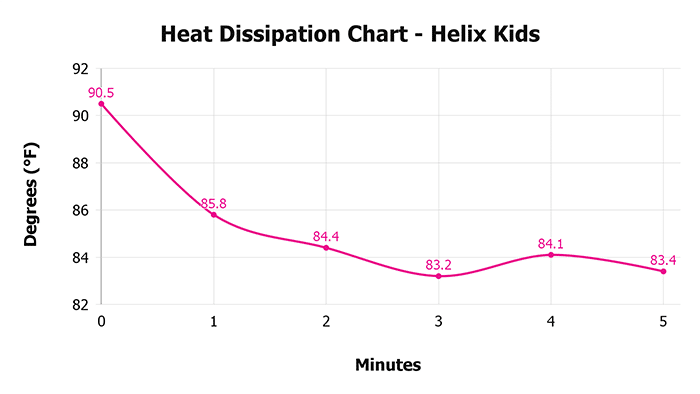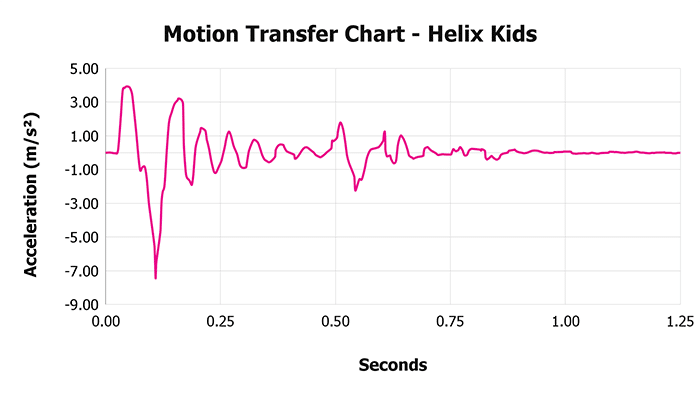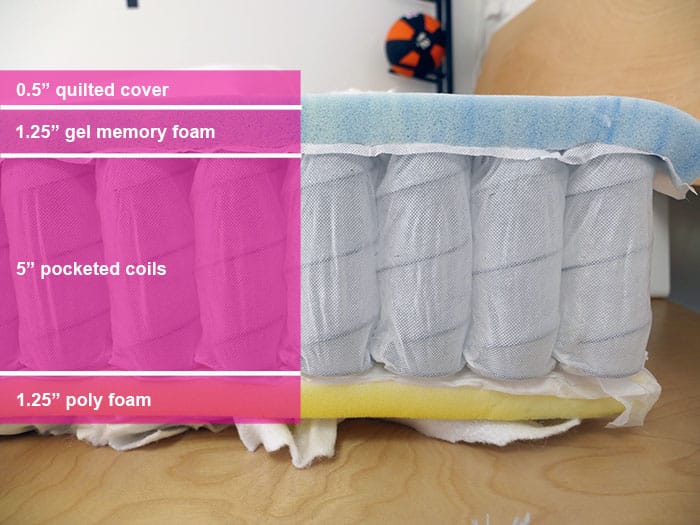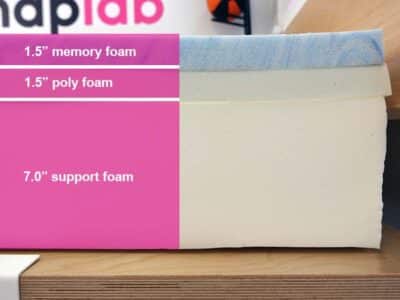
Best For
- Flippable design for different age ranges, can grow as your child grows
- Excellent edge support for lying
- Hybrid design offers excellent cooling
Considerations
- Designed for kids 12 and younger, not ideal for older kids or adults
- Firmer feel is great for stomach and back sleepers, but not ideal for many side sleepers. This becomes more of an issue the heavier your child is.
Our Verdict
The Helix Kids mattress is a flippable hybrid mattress that has foam top & bottom layers with a pocketed coil central core. Each side has a slightly different firmness that is designed for specific ages.
Side One is designed for 3-7-year-olds and is slightly firmer (8 out of 10 firmness). Side Two is designed for 8-12-year-olds and is slightly softer (but still fairly firm at a 7 out of 10).
The slightly firmer feel is generally better for children, as it creates a more robust and supportive sleeping surface. Additionally, the flippable design extends the useful life of the mattress. Most children up to the age of 12 should find it comfortable and supportive.
It has both moderate sinkage and bounce, which is great for children. It allows the surface to be lively enough to move around without an overly trampoline-like experience.
The Helix Kids mattress has an overall score of 8.25, ranking it among the top 50% of kids’ mattresses we’ve tested to date. Its price is also great compared to most kids’ mattresses, at $599. This is 33% or $300 cheaper than the average kids’ mattress.
Type: Kids
Firmness: Slightly Firm (7)
Best For: All Sleeping Positions, Kids Under 120lbs (3-12 years old)
In This Review
Performance Tests | Firmness | Support & Sleeping Positions | Design | Materials | Comparisons | FAQs
Performance Tests
At NapLab, we put each mattress to the test.
We test 10 different factors that impact the performance, comfort, and value of the mattress. We then take the results of that test and compare to every mattress we’ve tested to date.
Our tests and scores are based on the 8-12-year-old side of the mattress.
Check out the full performance table below to see how this mattress ranks:
| Factor | Helix Kids | Average |
|---|---|---|
| Overall Score | 8.25 | 8.55 |
| Price (Queen) | $599 | $899 (Kids only) |
| Cooling – Score | 9.0 | 8.7 |
| Sinkage – Depth | 1.95″ | 2.15″ |
| Sinkage – Feel | Minimal | Moderate |
| Motion Transfer – Score | 7.1 | 8.2 |
| Motion Transfer – Acceleration | 11.38 m/s² | 8.79 m/s² |
| Response Time – Score | 6.4 | 8.9 |
| Response Time – Mostly Recovered | 0.8 sec. | 0.4 sec. |
| Response Time – Fully Recovered | 1.5 sec. | 0.9 sec. |
| Bounce – Height | 9.21″ | 9.51″ |
| Bounce – Feel | Moderate | Moderate |
| Edge Support – Score | 8.9 | 8.6 |
| Edge Support – Sitting | 4.00″ | 4.04″ |
| Edge Support – Lying | Excellent | Good |
| Pressure Relief – Score | 8.0 | 8.7 |
| Comfort Layer Thickness | 1.8″ | 4.1″ |
| Mattress Thickness | 8.0″ | 12.0″ |
| Off-Gassing – Score | 9.4 | 8.2 |
| Off-Gassing – Smell | Minimal | Strong |
| Off-Gassing – Days | 2 days | 6 days |
| Company – Score | 9.4 | 8.8 |
| Trial | 100 nights | 177 nights |
| Warranty | 10 years | 25% have lifetime warranties, average of other 75% of mattresses is 13 years |
How is Helix Kids Different?
The Helix Kids mattress is a mattress for kids (age 3-12 years old) with slightly poorer overall performance than average, but also a lower price tag—33% less than the average kids’ mattress (a savings of $300).
Advantages
Advantages of the Helix Kids mattress include better cooling performance, slightly better edge support when seated at the edge.
Neutral Factors
This mattress has 9% less sinkage than average as well as 3% less bounce than average. These two factors are considered neutral factors since both values are within acceptable range and more an issue of personal preference.
Disadvantages
Disadvantages include higher levels of motion transfer as well as a slower material response time. The mattress is also quite a bit thinner than average, but remember this is compared to the average across all mattress types (not just kids mattresses.)
Oftentimes, children can get by with thinner mattresses due to their lighter body weights, but this may not be a great long-term solution if your child is already nearing the cut-off age.
Cooling Test
Cooling on the Helix Kids mattress was excellent. In our objective tests, we measured a maximum surface level temperature of 90.5°F.
Baseline Temp.
80.2° F
Max Temp.
90.5° F
Ending Temp.
83.4° F
This is 0.3°F cooler than the average across all mattresses we’ve tested to date. While the max temperature was kept in check, the really impressive story was the heat dissipation curve.
Max Temp.

Ending Temp

- Baseline Temperature – the temperature of the mattress before anyone lies on it
- Maximum Temperature (0 minute) – the temperature of the mattress after lying on it for 15 minutes
- Ending Temperature (5 minute) – the temperature of the mattress after being lied upon and having no one on it for 5 minutes
Within 1 minute after getting off the mattress the surface temperature dropped from 90.5° to 85.8°, a decline of 4.7°F.
This is 1.2° better than the average heat dissipation by 1 minute. There was a notable and gradual heat decline from 2-5 minutes before ending at 83.4°F.
Heat Dissipation Over Time

My subjective experience on the mattress mirrored what we saw from the data. Even an adult-sized body and adult weight did not create any notable heat issues on the mattress.
Sinkage Test
In our pressure point sinkage test, we measured a maximum sinkage of 1.95”.
Sinkage Depth
1.95″
Sinkage Feel
Minimal
Body Contour
Balanced
This is slightly below the average compared to all mattresses we’ve tested to date, which comes in at 2.15”.
The level of sinkage is documented in the image below.

A moderate level of sinkage is ideal for child sleepers. Children generally need less sinkage, which creates a more supportive sleeping surface.
Children also tend to spend more time sleeping on the stomach and back, both of which benefit from less deep sinkage. In all cases, the 1.95” is an ideal level of sinkage for child sleepers.
Motion Transfer Test
In our motion transfer tests, we measured an acceleration range of 11.38 m/s².
Accel. Range
11.38 m/s²
Motion Duration
0.86 seconds
The level of motion transfer is documented in the video below.
This is a good deal more than the average of 8.79 m/s².
This indicates that there is significantly more motion transfer on the Helix Kids mattress compared to most others.
That said, motion transfer is going to be less of an issue for most kid mattresses.
Motion Transfer Over Time

Unless your child shares a bed with a sibling or their own movements during the night are able to awaken them, more or less motion transfer won’t be as big of a factor.
Response Test
Response time was quite a bit slower than expected. It took 0.8 seconds for the mattress to mostly recover and 1.5 seconds before a full material recovery was able to complete.
Mostly Recovered
0.8 sec.
Complete Recovery
1.5 sec.
The level of responsiveness is documented in the video below.
This is quite a bit slower than the average. On average, mattresses are able to mostly recover within 0.6 seconds and a full material recovery finishes by 1.0 seconds (based on all of our mattress tests to date).
A slower responding mattress could result in some children feeling that it’s harder to move on the mattress or “stuck”. In general, I would have liked to have seen a faster response time.
However, the response times we see here aren’t crazy slow, just slower than they could be. For most children, the response time on the Helix Kids mattress should not be problematic.
Bounce Test
There was a high level of bounce on the Helix Kids mattress. During our tests, we measured a total bounce height of 9.21”.
Max. Depth
4.34″
Max. Rebound
4.87″
Total Bounce
9.21″
This is just slightly lower than the average bounce height of 9.51”. As far as sleep for kids goes, having a moderate level of bounce like this is ideal.
Max. Sinkage Depth

Max Bounce Height

The level of bounce is also documented in the video below.
It helps the mattress feel easy to move around on it, easy to get in and out of bed, and easy to change positions.
As far as fun goes, it still has enough pushback for kids to jump on the bed and use the mattress as a play surface (if mom and dad approve).
Edge Support Test
Edge support on the Helix Kids mattress was only good for sitting. While sitting directly on the edge we measured a maximum compression of 4.00”.
Max. Sinkage
4.00″
Lying Support
Excellent
Reinforced Edge
No
Considering the total thickness of this mattress, 4.00” is really impressive. Honestly, I was expecting a complete collapse of the edge while sitting. It is also slightly better than the average compression that we see, which is 4.04″.
Strong edge support on a kids mattress means the mattress is both supportive for kids while sleeping, and also supportive while reading, playing, or getting ready when using the edge of the mattress.
The level of edge support while seated is documented in the images below.
Sitting, 140 lbs.

Sitting, 200 lbs.

While lying directly on the edge of the mattress I felt equally as well supported as I did when lying closer towards the middle of the mattress.
The level of edge support while lying is documented in the images below.
Lying on Edge, 140 lbs.

Lying on Edge, 200 lbs.

Since the mattress was able to fully support my adult body weight while both sitting and lying there is no doubt it will be more than sufficient for children.
Pressure Relief Test
Pressure relief is good, but not great. However, I am less worried about that for a kids’ mattress.
Comfort Layer
1.75″
Support Layer
6.25″
Adults require a greater degree of pressure relief due to increased body weights and the increased strain and damage on the body over time.
Most children don’t have the same level of pressure relief needs that adults do.
Looking at the design of the mattress it makes sense. There is only 1.75” of comfort material on the mattress.
That’s simply not enough for an adult. However, for most children, it should be sufficient to create adequate pressure relief.

As your child gets begins to weigh more this is likely going to be the reason it’s time to upgrade to an adult mattress.
This is especially true if your child sleeps on their side. Side-sleeping children who are 10 and older are more likely to experience pressure issues.
The older and bigger they get, the more of an issue it could become. The closer your child is to a small adult the more likely this could be an issue.
Off-Gassing Test
Right out of the box the off-gassing on the Helix Kids mattress was minor. What little smell there was lingered for 2 days before dissipating.
Initial Smell Strength
Minimal
Off-Gassing Period
2 days
This is 3x better than the average dissipation time frame of 6 days. Overall, this is pretty standard stuff and not an area of significant concern.
Company
The company score takes a look at factors that may influence your experience with the mattress.
Factors include length of the trial period, warranty, shipping / return costs, and country of origin.
| Company Factor | Factor Weight | Score | Data |
|---|---|---|---|
| Returns | 40% | 10 | $0 |
| Trial Period | 30% | 8.0 | 100 nights |
| Warranty | 20% | 10 | Lifetime |
| Shipping | 10% | 10 | $0 |
| Country of Origin | 0% | USA |
Helix has been around since 2015 and their company terms and policies feel pretty fair and favorable. They offer a 100-night trial period, with a 30-night break-in period which is pretty standard.
Outside of their Kids mattress, they also offer a huge lineup of adult mattresses as well. So it’s a great brand for multiple sleepers in your house.
How firm is the Helix Kids?
From the Helix perspective, Helix tends to rate the sides a quite a bit softer than they are in my view.
Of course, it’s important to note that lighter sleepers will feel firmness differently.

My experience with personally rating the firmness of hundreds of mattresses estimates the Helix to be closer to the chart below.
- Age 8-12: 7 out of 10 (medium-firm)
- Age 3-7: 8 out of 10 (firm)

Support & Sleeping Positions
The Helix Kids mattress is designed for kids 12 and under so sleeping positions is a little less relevant than it may be on an adult mattress.
| Support Factor | Data |
|---|---|
| Comfort Layer | 1.75″ |
| Support Layer | 6.25″ |
| Firmness | Slightly Firm |
| Body Contour | Balanced |
| Zoned Support | No |
| Reinforced Edge | No |
Materials are designed to support all sleeping positions for sleepers up to 500 lbs, although children will likely exceed the age recommendation before they exceed the weight restriction.

The image above shows how the level of sinkage varies when more weight is applied—or should I say BARELY varies. In this test, I put on a 60 lb. weighted vest to take my 140 lb. body weight up to 200 lbs. total.
Even with the extra weight, you can see that the Helix Kids mattress still supports the weight very well. Support is evenly distributed and I felt comfortable on this mattress.
Design
The Helix Kids is a flippable hybrid mattress designed for children, ages 3-12. One side is firmer and the other is a touch softer.
| Design Factor | Data |
|---|---|
| Type | Kids |
| Thickness | 8″ |
| Cover Type | Quilted |
| Weight | 37 lbs. |
| Has Handles | No |
| Fiberglass-Free | Yes |
| Ships in a Box | Yes |

Materials
The Helix Kids mattress has a stain and water-resistant quilted cover. Inside the cover are two layers of foam that sandwich a central pocketed coil core.
| Layer Type | Thickness | Layer Specs |
|---|---|---|
| Quilted Cover | 0.5″ | Not Available |
| Memory Foam | 1.25″ | Not Available |
| Pocketed Coils | 5.0″ | Not Available |
| Poly Foam | 1.25″ | Not Available |

Together, these materials give the mattress a good bounce from the coils, paired with pressure relief and comfort from the foam layers.
The Helix Kids is hypoallergenic and also includes an odor-fighting microbe shield treatment on the cover.
The Cover
The cover of the Helix Kids mattress is a 0.5″ Tencel cover. It has a plush feel, but is still relatively flat, with horizontal stitching detail that stretches across the width of the mattress.

For kids, especially younger kids, a slightly firmer mattress with a somewhat flat finish is better for sleeping.
Mattresses with too soft of a cover or too much compression can create support issues for children.

From the side of the mattress, you can easily see which side is designed for each age range. Simply flip the mattress over to the appropriate side and you’re good to go.
The Comfort Layer
Depending on what side the mattress is on, there are two different comfort layers.

For Side One, for kids 3-7, the comfort layer is a 1.25″ layer of poly foam. This foam is firmer than the opposite side and has a great firmness for kids transitioning out of infant or toddler beds, which are oftentimes even firmer than this.
For Side Two, kids 8-12 years old, the comfort layer is a 1.25″ layer of gel memory foam. This is a little softer than the other side and because it is softer, the gel infused into the foam helps to remain cool.
The Support Layer
Similar to the comfort layer, the support layer varies depending on which side the mattress is on.

If you’re lying on Side Two, designed for 8-12 year olds, the support layer will be the 1.25″ of poly foam. If you’re lying on Side One, designed for 3-7 years olds, the support layer will be the 1.25″ of gel memory foam.
Lightweight sleepers, ages 3-7, will engage less with the support foam because of their lighter weight, but the support foam is still an important part of the mattress as children grow.
Product Evolution
The Helix Kids mattress was first introduced in Q4 of 2021 and there have been no product evolution changes since its launch. As a company, Helix continues to grow and change, bringing in new models and tweaking older models as they do.

I would expect to see small changes to this mattress as it ages, but right now it’s pretty fresh off the presses and Helix is only just beginning to collect consumer feedback on this mattress.
Other Mattresses to Consider
Looking for other options specifically designed for your pint-sized dreamer? Check out three other top-rated mattresses for kids below.
For Great Cooling

Purple Kids
Combo Foam on a Budget
The Purple Kids mattress is a slightly softer version of the Original Purple mattress. It has the same 2.0″ patented Purple Grid and is designed to support sleepers up to 115 lbs (or approx. 14 years old).
For Twin XL

Saatva Youth
Luxury Coil-On-Coil
The Saatva Youth mattress is another great option designed specifically for kids. Like the Helix, the Saatva is also flippable. One advantage of the Saatva over the Helix is that it comes in a Twin XL size. The top also has more contour and hug.
For Balanced Feel

Leesa Studio
Combo Foam on a Budget
While it’s not a true “kids mattress”, the Leesa Studio makes a great option for young sleepers. It’s a lower price compared to the Leesa Original, but still offers great performance and 3.0″ of comfort foam.
Frequently Asked Questions
Still have questions? Check out some of the top FAQs on the Helix Kids mattress below and get the answers you’re looking for.
Here are the current prices, with any sales or promotions reflected below:
Twin: $599
Twin XL: NA
Full: $799
Queen: NA
King: NA
Cal. King: NA
As shown above, the Helix Kids is only available in Twin and Full.
*Note: Sales prices are subject to change without notice or warning.
The Helix Kids comes with a 100-night trial period. If at any point during that time you decide that the Helix isn’t right for your child, you can return the mattress at no cost.
No. The best way to try the Helix mattress is to take advantage of the 100-night trial period.
The Helix Kids mattress is not waterproof, but it is water-resistant. The cover has an eco-friendly and plant-based durable water-repellent finish that protects the mattress from stains and water damage.
Vacuum dry debris. Or spot clean with cold water and mild detergent. To avoid stains and spills altogether, consider adding a waterproof mattress pad or a 6-sided mattress encasement.



